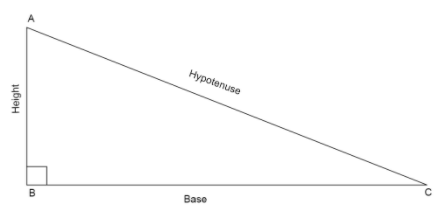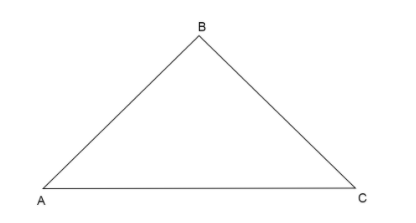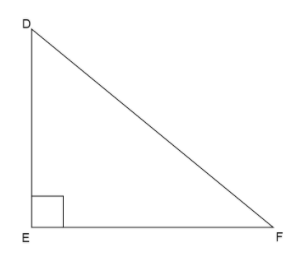
In a triangle, if the square of one side is equal to the sum of squares of other sides, then the angle opposite to the first side is a right angle. Prove it.
Answer
587.4k+ views
Hint: We prove this statement by considering another triangle which is a right angled triangle and has two sides equal to two sides of the given triangle. Using the Pythagoras theorem in the triangle we constructed, find the value of third side and show both the triangles congruent to each other.
* Pythagoras theorem states that in a right angled triangle, the sum of square of base and square of height is equal to square of the hypotenuse.
If we have a right angled triangle, \[\vartriangle ABC\] with right angle, \[\angle B = {90^ \circ }\]
Then using the Pythagoras theorem we can write that \[A{C^2} = A{B^2} + B{C^2}\]

Complete step-by-step answer:
Let us assume a triangle given to us in the question as \[\vartriangle ABC\], which has a square of one side equal to the sum of squares of other sides.

Now we are given for \[\vartriangle ABC\], let the side whose square is equal to the sum of squares of the other two sides be \[AC\]. So, we can write
\[A{C^2} = A{B^2} + B{C^2}\] … (i)
Now we assume another triangle which is a right angle triangle, say \[\vartriangle DEF\] with \[\angle E = {90^ \circ }\] and two sides equal to sides of \[\vartriangle ABC\], say \[AB = DE,BC = EF\]

In right angle triangle, \[\vartriangle DEF\], using Pythagoras theorem we can write
Square of hypotenuse is equal to sum of square of base and square of height.
Here, base is \[EF\], height is \[DE\] and hypotenuse is \[DF\].
\[ \Rightarrow D{F^2} = D{E^2} + E{F^2}\] … (ii)
Now we know from equation (i)
\[A{C^2} = A{B^2} + B{C^2}\]
Substitute the values of \[AB = DE,BC = EF\] in equation (i)
\[ \Rightarrow A{C^2} = D{E^2} + E{F^2}\]
But we know from equation (ii) \[ \Rightarrow D{F^2} = D{E^2} + E{F^2}\]
\[ \Rightarrow A{C^2} = D{F^2}\]
Taking square root on both sides of the equation,
\[
\Rightarrow \sqrt {A{C^2}} = \sqrt {D{F^2}} \\
\Rightarrow AC = DF \\
\]
Therefore, now we have all three sides of \[\vartriangle ABC\] equal to three sides of \[\vartriangle DEF\]as
\[
AB = DE \\
BC = EF \\
AC = DF \\
\]
So, by Side Side Side (SSS) congruence rule, we can say that \[\vartriangle ABC \cong \vartriangle DEF\].
Since, we know two triangles which are congruent have their corresponding sides equal and their corresponding angles equal.
Here, corresponding angles of \[\vartriangle ABC \cong \vartriangle DEF\] are
\[
\angle A = \angle D \\
\angle B = \angle E \\
\angle C = \angle F \\
\]
So we can say \[\angle B = \angle E = {90^ \circ }\] because \[\angle E = {90^ \circ }\].
Therefore, \[\vartriangle ABC\] is a right angled triangle with \[\angle B = {90^ \circ }\].
Hence Proved.
Note: Students many times make mistake while applying Pythagoras theorem to a right triangle and they write any side on LHS of the equation and other two remaining sides on RHS of the equation which is wrong, the sides whose square we take on one side always has to be the hypotenuse, which can be identified as the side opposite to right angle.
* Pythagoras theorem states that in a right angled triangle, the sum of square of base and square of height is equal to square of the hypotenuse.
If we have a right angled triangle, \[\vartriangle ABC\] with right angle, \[\angle B = {90^ \circ }\]
Then using the Pythagoras theorem we can write that \[A{C^2} = A{B^2} + B{C^2}\]

Complete step-by-step answer:
Let us assume a triangle given to us in the question as \[\vartriangle ABC\], which has a square of one side equal to the sum of squares of other sides.

Now we are given for \[\vartriangle ABC\], let the side whose square is equal to the sum of squares of the other two sides be \[AC\]. So, we can write
\[A{C^2} = A{B^2} + B{C^2}\] … (i)
Now we assume another triangle which is a right angle triangle, say \[\vartriangle DEF\] with \[\angle E = {90^ \circ }\] and two sides equal to sides of \[\vartriangle ABC\], say \[AB = DE,BC = EF\]

In right angle triangle, \[\vartriangle DEF\], using Pythagoras theorem we can write
Square of hypotenuse is equal to sum of square of base and square of height.
Here, base is \[EF\], height is \[DE\] and hypotenuse is \[DF\].
\[ \Rightarrow D{F^2} = D{E^2} + E{F^2}\] … (ii)
Now we know from equation (i)
\[A{C^2} = A{B^2} + B{C^2}\]
Substitute the values of \[AB = DE,BC = EF\] in equation (i)
\[ \Rightarrow A{C^2} = D{E^2} + E{F^2}\]
But we know from equation (ii) \[ \Rightarrow D{F^2} = D{E^2} + E{F^2}\]
\[ \Rightarrow A{C^2} = D{F^2}\]
Taking square root on both sides of the equation,
\[
\Rightarrow \sqrt {A{C^2}} = \sqrt {D{F^2}} \\
\Rightarrow AC = DF \\
\]
Therefore, now we have all three sides of \[\vartriangle ABC\] equal to three sides of \[\vartriangle DEF\]as
\[
AB = DE \\
BC = EF \\
AC = DF \\
\]
So, by Side Side Side (SSS) congruence rule, we can say that \[\vartriangle ABC \cong \vartriangle DEF\].
Since, we know two triangles which are congruent have their corresponding sides equal and their corresponding angles equal.
Here, corresponding angles of \[\vartriangle ABC \cong \vartriangle DEF\] are
\[
\angle A = \angle D \\
\angle B = \angle E \\
\angle C = \angle F \\
\]
So we can say \[\angle B = \angle E = {90^ \circ }\] because \[\angle E = {90^ \circ }\].
Therefore, \[\vartriangle ABC\] is a right angled triangle with \[\angle B = {90^ \circ }\].
Hence Proved.
Note: Students many times make mistake while applying Pythagoras theorem to a right triangle and they write any side on LHS of the equation and other two remaining sides on RHS of the equation which is wrong, the sides whose square we take on one side always has to be the hypotenuse, which can be identified as the side opposite to right angle.
Recently Updated Pages
Find the zeros of the following quadratic polynomials class 10 maths CBSE

what is the coefficient of x2 in each of the following class 10 maths CBSE

The halide ore of sodium is called as A Horn salt B class 10 chemistry CBSE

Is a dependent pair of linear equations always consistent class 10 maths CBSE

The total value with GST of a remotecontrolled toy-class-10-maths-CBSE

Major difference between phloem of angiosperms and class 10 biology CBSE

Trending doubts
The average rainfall in India is A 105cm B 90cm C 120cm class 10 biology CBSE

Why is there a time difference of about 5 hours between class 10 social science CBSE

What is the median of the first 10 natural numbers class 10 maths CBSE

Who Won 36 Oscar Awards? Record Holder Revealed

Write a letter to the principal requesting him to grant class 10 english CBSE

The Equation xxx + 2 is Satisfied when x is Equal to Class 10 Maths




